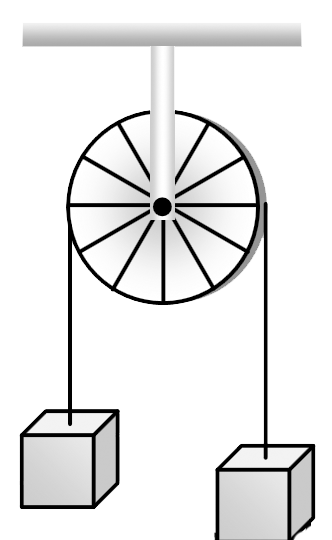A long cylindrical pipe of radius 20 cm is closed at its upper end and has an airtight piston of negligible mass as shown. When a 50 Kg mass is attached to the other end of the pistion, it moves down by a distanceΔl before coming to equilibrium. Assuming air to be an ideal gas, Δl/L (see figure) is close to (g = 10 ms2 , atmospheric pressure is 105 Pascal),

0.01
0.02
0.04
0.09
The correct Answer is:C
Step by step video, text & image solution for A long cylindrical pipe of radius 20 cm is closed at its upper end and has an airtight piston of negligible mass as shown. When a 50 Kg mass is attached to the other end of the pistion, it moves down by a distanceDeltal before coming to equilibrium. Assuming air to be an ideal gas, Deltal//L (see figure) is close to (g = 10 ms^(2) , atmospheric pressure is 10^(5) Pascal), by Physics experts to help you in doubts & scoring excellent marks in Class 12 exams.
Updated on:21/07/2023Topper's Solved these Questions
Similar Questions
A cylindrical tube of cross sectional area 20cm2 is filled with water to a height of 10cm. The tube carries a tight fitting piston of negligible mass. What will be the pressure exerted at the bottom of the tube when a mass of 2 kg placed on the piston? Atmospheric pressure can be ignored.
View SolutionA cylinderical jar of cross-sectional area of 50cm2 is filled with water to a height of 20cm. It carries a tight fitting piston of negligible mass. Calculate the pressure at the bottom of the jar when a mass of 1kg is placed on the piston . Ignore atmospheric pressure.
View Solution
Knowledge Check
A long cylindrical pipe of radius 20 cm is closed at its upper end and has an airtight piston of negligible mass as shown. When a 50 Kg mass is attached to the other end of the pistion, it moves down. If the air in the enclosure is cooled from temperature T to T–ΔT, the piston moves back to its original position. Then ΔT/T is close to (Assuming air to be an ideal gas, g=10m/s2, atmospheric pressure is 105 Pascal),
 A0.01B0.02C0.04D0.09
A0.01B0.02C0.04D0.09A person blows into open- end of a long pipe. As a result, a high pressure pulse of air travel down the pipe. When this pulse reaches the other end of the pipe,
A(a) a high -pressure pulse starts travelling up the pipe, if the other end of the pipe is open.B(b) a low -pressure pulse starts travelling up the pipe, if the other end of the pipe is open.C( c ) a low -pressure pulse starts travelling up the pipe, if the other end of the pipe is closed.D(d) a high -pressure pulse starts travelling up the pipe, if the other end of the pipe is closed.A pipe of length 10 cm, closed at one end, has a frequency equal to half the 2nd overtone of another pipe open at both the ends. What is the length of the open pipe ?
A10 cmB20 cmC35 cmD30 cm
A hollow cylindrical pipe of mass M and radius R has a thin rod of mass m welded inside it, along its length. A light thread is tightly wound on the surface of the pipe. A mass m0 is attached to the end of the thread as shown in figure. The system stays in equilibrium when the cylinder is placed such that α=30∘ The pulley shown in figure is a disc of mass M2
(a) Find the direction and magnitude of friction force acting on the cylinder.
(b) Express mass of the rod ‘m’ in terms of m0

View SolutionTwo pistons of a hydraulic machine have diameters 20 cm and 2 cm. Find the force exerted on the larger piston when 50 kg wt is placed on the smaller piston. When the smaller piston moves is throught 50 cm, by what distance the other piston moves out ?
View SolutionOne end of a cylinderical pipe has a radius of 2 cm. Water comes out at 10 m/s. The rate at which mass is leaving the pipe is
View SolutionTwo particles of mass 5 kg and 10 kg respectively are attached to the twoends of a rigid rod of length 1 m with negligible mass. the centre of mass of the system from the 5 kg particle is nearly at a distance of :
View SolutionA light string passes over a frictionless pulley. To one of its ends a mass of 6 kg is attached. To its other end a mass of 10 kg is attached. The tension in the thread will be

View Solution

